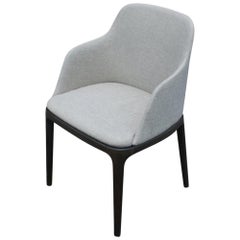Poliform Grace
Recent Sales
Early 2000s European Modern Side Chairs
Oak
Early 2000s European Modern Side Chairs
Oak
Early 2000s European Modern Side Chairs
Oak
A Close Look at modern Furniture
The late 19th and early 20th centuries saw sweeping social change and major scientific advances — both of which contributed to a new aesthetic: modernism. Rejecting the rigidity of Victorian artistic conventions, modernists sought a new means of expression. References to the natural world and ornate classical embellishments gave way to the sleek simplicity of the Machine Age. Architect Philip Johnson characterized the hallmarks of modernism as “machine-like simplicity, smoothness or surface [and] avoidance of ornament.”
Early practitioners of modernist design include the De Stijl (“The Style”) group, founded in the Netherlands in 1917, and the Bauhaus School, founded two years later in Germany.
Followers of both groups produced sleek, spare designs — many of which became icons of daily life in the 20th century. The modernists rejected both natural and historical references and relied primarily on industrial materials such as metal, glass, plywood, and, later, plastics. While Bauhaus principals Marcel Breuer and Ludwig Mies van der Rohe created furniture from mass-produced, chrome-plated steel, American visionaries like Charles and Ray Eames worked in materials as novel as molded plywood and fiberglass. Today, Breuer’s Wassily chair, Mies van der Rohe’s Barcelona chair — crafted with his romantic partner, designer Lilly Reich — and the Eames lounge chair are emblems of progressive design and vintage originals are prized cornerstones of collections.
It’s difficult to overstate the influence that modernism continues to wield over designers and architects — and equally difficult to overstate how revolutionary it was when it first appeared a century ago. But because modernist furniture designs are so simple, they can blend in seamlessly with just about any type of décor. Don’t overlook them.
Finding the Right side-chairs for You
Antique and vintage side chairs are space savers by design and wonderfully versatile pieces of seating for your dining room or wherever guests may gather.
Chairs have been indispensable pieces of furniture for a long time. We sit, therefore we deserve good seating. In Ancient Egypt, chairs were utilized in homes regardless of class, and most furniture was made of wood. Comfortable folding chairs, for example, were found in King Tutankhamun’s tomb.
Chairs evolved to be more commonplace in the 1830s, and by the Industrial Revolution, they could be found in most homes. The traditional wooden side chair might feature an upholstered back and seat and was typically used for gathering around a big dining room table. Because the side chair does not feature armrests, it could easily be tucked under the table when not in use or delicately placed in a corner for decorative purposes. Today, the side chair’s slim silhouette and armless design still offer the same level of versatility as it did in its early days. It’s supportive of a large gathering for a meal in the dining room or kitchen and serves as an accent piece (or extra seating) resting against the wall in a living room or inviting foyer.
When shopping for side chairs, think about the colors and furniture style you’ve already introduced to your living room or dining room. Keep the height of your sofa in mind, for example. If you intend to pair your sofa with your side chair when it’s not perched near the dining table, it wouldn’t hurt if the height of your side chair matches the height of your sofa. Even if your side chair will largely be used in the kitchen or dining room, it will likely be used in the living room or home entertainment area as well. When you’re thinking about the seating where meals are served in your home, benches, stools and armchairs make suitable alternatives too. And if you’re feeling adventurous, combining a variety of dining room seating options can be both aesthetically pleasing and downright practical.
Side chairs are available in a number of styles today, and this convenient seating is one of the types of chairs you should know when furnishing your new home. Explore antique and vintage side chairs on 1stDibs. Find Art Deco side chairs and mid-century modern side chairs, or search by creator to find side chairs crafted by legendary designers like Charles and Ray Eames and others.

